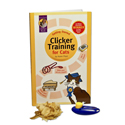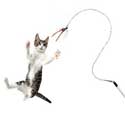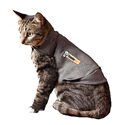A new addition to the family
When I brought Mimi the Burmese home at the age of 12 weeks, I was quite worried about my older dog. I felt sure that my young poodle, Misha, and the new kitten would rapidly become friends and playmates (which they did). However Twitchett, a 9-year-old border terrier, represented a serious threat. In fact, one senior animal behaviorist had e-mailed me advising that I rethink my plan of getting a kitten.

Mimi and Twitchett
Natural conflict?
Twitchett, like all terriers, was bred to hunt small prey, and she was a fanatic. Where I used to live, in the mountains of the Pacific Northwest, Twitchett had pursued, caught, killed, and dragged into the house a wide variety of critters, from mice and rats to a half-grown opossum. As far as I know, she never caught a cat, but she had been allowed, and indeed encouraged, to drive feral cats off the property in order to protect the birds at my bird feeders. In her view, chasing cats, and killing them if possible, would be both a responsibility and a pleasure.
Twitchett knew, from both instinct and practice, how to grab and shake a small animal all in one motion to break its spine. At least at first, one unguarded exposure of terrier to cat and this cherished (and expensive) kitten might be dead. Here's how I used the clicker to solve the problem.
Preliminary strategy
I established the kitten in my home office with the door closed. Until further notice I would play with and clicker train the kitten only in the office or the kitchen. I kept Twitchett in another part of the house, also behind closed doors.
On the first evening I shut Twitchett up in a sturdy airline shipping crate in the kitchen and put Misha, the gentlemanly poodle, on a leash. The cat was released to investigate them. Misha responded to the kitten's approaches with dog-to-dog social behavior: sniffing, licking, tail wagging, and giving the calming signals of a lowered or averted head if the cat glared at him. Perfect. Twitchett, meanwhile, howled, yapped, and scratched at the crate door continuously, especially when the kitten (of course) jumped up onto the crate and peered insolently through the air holes. I let this go on for 15 minutes, then put the cat back in the office with her dinner and released the dogs and fed them.
Round two
On the second evening of close encounters in the kitchen, Misha was allowed to play with the cat, with his leash trailing and me hovering behind to step on it if a chase got too rough. Twitchett, watching from the crate, howled continuously and tried to get out. "That's a cat. Let me out, I can get rid of it for you!"
I clicked and treated Twitchett for any brief moments of silence. I also fed treats to the cat with each click, to maintain her clicker conditioning. After five or ten minutes of this, I put the cat back in the office and released the dogs into the living room, using a baby gate in the hall between the rooms to prevent Twitchett from snuffing, crying, and scratching at the office door all night, as she was undoubtedly planning to do.
Playmates, treats, and the evening news
For the next few nights, while the evening news was running on the TV, I tethered both dogs to heavy furniture in the living room, supplied myself with clickers and treats, and let the kitten in (she was dying of curiosity and anxious to join us). The kitten could go where she wanted, and soon she and Misha began learning how to play together. Meanwhile I clicked Twitchett for looking away from the cat, however briefly, then for relaxing into a sit (uncued by me), then for relaxing further and lying down, and then for lying down and watching me.
I started using a verbal marker for Twitchett, the word "Good," which she knew meant "click" but the others didn't. Gradually Twitchett began regarding these evening social sessions not as a thwarted opportunity to chase cats, but as an opportunity to be clicked and treated. Her focus shifted from panting, quivering attention on the kitten, to yearning, wide-eyed attention on me. "Will I get clicked? How can I persuade her of my need for more food?"
Daredevil cat
By the time we'd done this nightly for a week or so, the kitten began to take what I considered terrible chances. Once when Twitchett was standing still, hoping for a click, the kitten dashed right through her legs and vanished under the couch, moving so fast that Twitchett could only stare. Then she took to batting Twitchett's whiskers and tail (click, treat) and then to rolling on her back and letting Twitchett lick and nibble her belly fur. I was nervous, but it was the cat's initiative, so I let it happen. As a precaution, I kept the tethered Twitchett right next to me and also held her firmly by the collar, and I put the kitten away at once if the terrier began whining or showing increased excitement. Mimi ended these sessions sopping wet, but she didn't seem to mind. Twitchett ended them with a click and a big treat.
Mimi had been with us about three weeks when she completed Twitchett's cure. Twitchett, tethered as usual, was lying next to me and quietly enjoying a new bone when Mimi jumped off the couch and landed on her back. Twitchett didn't even turn her head—she just picked up her bone and moved away.
I knew that the worst was over. Twitchett had just treated the kitten as a sort of puppy, as a juvenile social acquaintance rather than prey. "Don't bother me now, kid. I'm busy." From then on I began to allow Twitchett off the leash for brief periods of social play with the cat. As Mimi ferociously attacked Twitchett's front leg, or left ear, or wagging tail, the dog just looked at me: "Do I get clicked for this?" Yes indeed.
Mimi then began to initiate chases with Twitchett, bouncing sideways and then bolting away right under her nose. A risky sport, I thought, but the cat had a plan. Just when Twitchett was about to catch her, she disappeared. Then, while the dog stood still, looking around in confusion ("Where'd she go? She was right here, I almost had her!"), from some nearby shelf or table the cat would drop onto Twitchett's back.
Twitchett just hated this. The look of confusion and embarrassment on her face was priceless. Finally she would respond to a chase invitation, run three or four steps, and then stop, sigh ("I know where this is going"), and grumpily come back to the couch and lie down. Dogs play checkers, but cats play chess.
One big family
Until Mimi was about six months old I kept her shut safely away from Twitchett whenever I wasn't home, in case the two dogs chased the cat together and things got out of hand, but finally even that precaution became unnecessary. Twitchett now treats Mimi like a beloved child. She washes Mimi's face every morning, takes naps curled up with her on the couch, and lets her steal her toys. All three animals greet guests at the door. We are a family.
Does this all seem like a lot of trouble? It really wasn't. It took me 10 or 20 minutes a night, while I was watching the news anyway. As long as we were making progress, I knew we would reach the goal of complete peace, and we did. Was it worth it? You bet! Otherwise I couldn't have a cat—and everyone needs a cat.
Excerpted from Getting Started Clicker Training for Cats, by Karen Pryor.








Disappointed
While I am fascinated by clicker training, I'm really disappointed (and frankly more than a little ticked off) by a couple of things. 1) With all the kittens and cats in shelters and foster homes needing good, loving homes, the author purchases an expensive cat! This only furthers the unnecessary breeding of cats (and dogs)! It uses female cats for breeding purposes without any regard for her health! 2) The other thing is that the author has encouraged her dogs to chase and run off the feral cats from her property!!!! How dare she?!!! This is the part that just ticks me off really bad! Like the birds are just wonderful because she feeds them, but these feral cats that started off from a domesticated cat being tossed out into the wild by uncaring, evil, souless humans don't deserve to be on her property! What a load of crap! Right now we have a stray momma kitty with 5 babies that will likely be classified as feral since they run from us humans (they've learned not to trust humans) and are too skittish to be socialized to us. The momma is sweet, gentle and loves to be petted. There is also another kitten from a previous litter that followed her from somewhere. I make my dog stay away from them, make sure the babies are put away under the house before I let our dog outside, feed them and will spay/neuter them when the time comes. To hear that some fool has encouraged her dogs to chase feral cats just really makes me mad!
Seems like this is a common problem - and my problem too!
We have adopted a 20 month old lab. He is playful, loving to the people in our pack and coming along well with basic training. Our cats are used to dogs, having lived with two in the past. We didn't anticipate bringing the new guy home would be any more difficult than it was bringing our last dog home. Boy were we wrong.
Sam, our new lab, goes beserk when he sees the cats. They have been living cordoned off in the basement for a few weeks now as we try to help him realize that his behaviour doesn't measure up. We aren't getting far in acclimating him to them as the two cats are TERRIFIED of him now. When we take him down to their zone, on his leash of course, they immediately run. This reinforces his belief that he is supposed to chase them...Argh.
Is there something more I can try? Has anyone had success with a hard-core cat hater??? I loved reading Karen's story, but as my cats won't initiate any contact with Sam, I am not sure how to breakdown the barriers to happy homelife here. I have wondered about crating up the cats so that they can't run when he approaches them, but I am afraid they would feel so threatened that it might move things backwards rather than forwards.
D.
cat chasing problem
I have a 8 month old shar-pei, Claude, and a 5 month old kitten and they get along just fine. They always did...
One of the reasons I adopted the kitten was that my boy was becoming crazy every time we saw a cat in
the street. However this situation hasn't changed and I feel horrible that I cannot control him. The dog trainer
advised me to use a citronella collar, but the outcome was that he was terrified to even go near the areas
where the cats hang out. He even started to be afraid of me everytime I called him for a walk. I feel I have
ruined my relation with him, does anyone have any suggestions about how to handle this problem?
Thanx
Encouraging!
I am in the process of curing my cat-chasing dog. His "little sister" is a 4 month kitten and I am taking it very slowly. He has always been curious of cats and has become conditioned over time that when he approaches one they either hiss and swat or run away, so his reaction is to chase. He is at the point where he is doing very well when she comes out of her safe room and has "visitation" in the big dog crate, he lays right next to it while she tries to bat at him for attention. He has gotten used to looking at me for a click and treat and does so whenever she bats at him-pretty darn cute. One question...he is a big guy (100 lb) and in the begining snapped/mouthed at her feet, so I am concerned about the time coming when I have her run loose even while he is on leash. I am afraid that it will only take one swift move and one chomp from him and she would be a goner if his chase instinct gets the best of him. I am considering getting him accustomed to a muzzle but wanted to ask your view. He is so strong I have nothing to tether him to securely!
Great story
Thank you for a great story, and as usual with a few laughs too - I love the "dogs play checkers, but cats play chess" comment!
I like the method, I usually recommend clients a slow systematic desensibilisation, but I can see how the addition of the clicker is likely to speed things right along
Christina
Armed and ready!
I just adopted what looks to be a German Shephard/Foxhound mix from my local city shelter. I am very worried about the safety of my cat. I have started clicker training, but she seems to be afraid of the clicker noise. Any suggestions?
liz
RE: Armed and ready!
You could try using the click of a ballpoint pen instead - quieter sound. Or muffle it with a cloth and hold it behind your back.
Post new comment